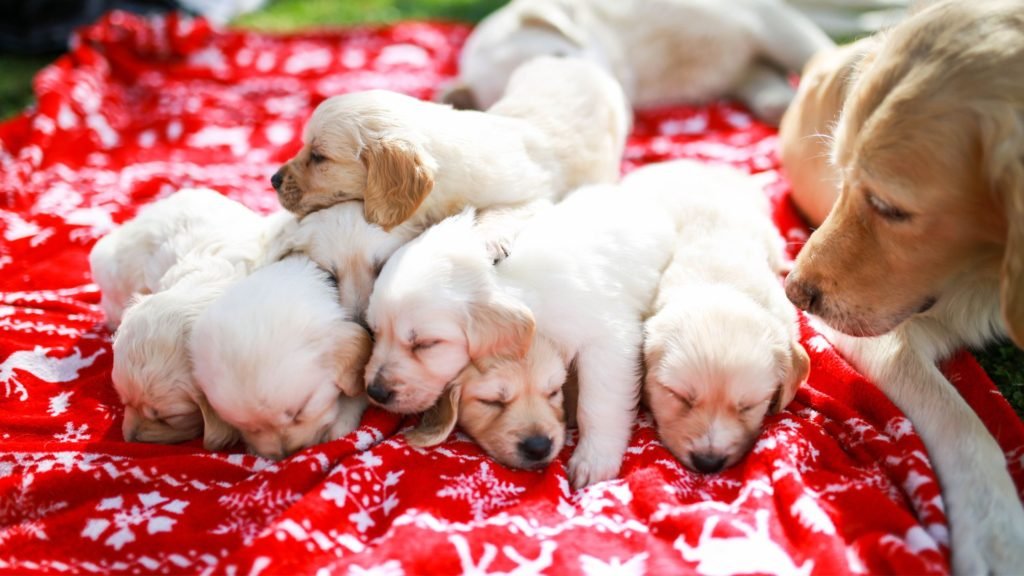In many instances, the question “Can you breed sibling dogs from same litters?” is met with caution due to the potentially high risk of health issues arising over time. Even carefully planned and managed inbreeding can result in unpredictable problems.
Breeding dogs of the same breed requires some inbreeding to maintain their traits. But breeders should avoid using dogs with the same parents or ancestors within a four-generation pedigree to preserve genetic diversity.
The Intricacies of Inbreeding in Canines
For many, the thought of inbreeding in any species, including canines, raises ethical concerns and health alarms. When asking, “Can you breed sibling dogs from the same litter?” it’s important to note that while the laws and perceptions surrounding inbreeding in humans don’t apply to dogs, that doesn’t mean inbreeding is without risks or complications in puppies.
In the animal kingdom, dogs don’t possess the same emotional awareness or moral codes as humans. Thus, a male dog may naturally attempt to mate with his sister, unaware of the potential consequences. The act seems easier since the dogs are familiar with each other and their scents.
Yet, even though the breeding process is mechanically possible, it still needs to be beneficial and ethically acceptable. Despite the legality of inbreeding in dogs, there are significant health concerns and potential genetic complications that breeders must consider when contemplating, “Can you breed sibling dogs from same litters?” We’ll delve further into these implications in the following sections.

The Concept of Predictability in Breeding Sibling Dogs
Desirable Traits and Genetic Material
When contemplating “Can you breed sibling dogs from same litters?” one factor often arises is predictability. Breeding brother and sister dogs, particularly those with excellent health and aesthetics, can theoretically produce offspring with similar desirable traits. This likelihood is due to the siblings sharing a significant portion of genetic material, potentially strengthening these traits within the breed.
Development of Recognized Dog Breeds
Breeding dogs with similar traits repeatedly has led to determined dog breeds. This process has resulted in consistent appearances within breeds, such as Labradors looking like Labradors and Pomeranians resembling Pomeranians.
Logistical Simplicity
From a logistical perspective, the question, “Can you breed sibling dogs from same litters?” offers an apparent simplicity. Dog owners can save substantial time and resources they would otherwise spend on finding a compatible stud for their dams. Using a brother from the same litter can reduce fees and contract complexities.
Considering the Health Risks
However, it’s essential to note that this approach comes with risk. Breeding siblings also carry significant health and genetic risks, making it a controversial practice in the dog breeding community. In the following sections, we’ll delve into these potential issues and why they may make you think twice about breeding sibling dogs.
Understanding the Risks of Breeding Sibling Dogs
In answering the question, “Can you breed sibling dogs from same litters?” it’s crucial to address the potential risks. While the shared genetics between siblings may seem to promise a healthy litter, this is unfortunately not always the case.
The Unseen Genetic Carriers
Despite appearing healthy and not displaying any negative traits, two dogs might still be carriers for certain genetic issues. These carriers often possess recessive alleles, which may remain hidden until they are combined in later breedings. It’s then that these negative traits might manifest in their offspring.
Health Issues in Inbred Dogs
Common issues faced by inbred dogs, often resulting from breeding siblings, include hip dysplasia and heart and liver conditions. These problems can surface at any stage in a dog’s life, creating potential health risks for your pets.
The Importance of Genetic Risk Assessment
Given these risks, a comprehensive genetic risk assessment is crucial before breeding sibling dogs. Even if they appear to be perfect specimens on the surface, their unseen genetic challenges might lead to problems. In the next section, we’ll further discuss the ethical implications of breeding sibling dogs and why many in the dog breeding community have reservations about this practice.

The Consequences of Reducing the Gene Pool
When answering “Can you breed sibling dogs from same litters?”, an important factor to consider is the potential impact on the breed’s gene pool.
Evolutionary Disadvantages
Breeding siblings significantly reduces the size of a breed’s gene pool. From an evolutionary perspective, this limitation is generally viewed as problematic. Certain breeds may become more prone to specific diseases or even death from those diseases as the gene pool becomes more restricted. Future generations may need help avoiding inheriting genes predisposing them to these health problems.
Breed-Specific Examples
For instance, Great Danes are susceptible to life-threatening conditions such as bloat, which reduces their average lifespan to 8-10 years. Similarly, Dogue de Bordeaux dogs face a high risk of breathing difficulties and overheating, limiting their expected lifespan to 5-8 years.
The Long-Term Implications of Inbreeding
If Great Danes and Dogue de Bordeaux dogs are continually bred with their siblings, their genetic lines are likely to experience these and similar health problems perpetually. Insufficient dogs carrying predominantly good genetic material in the gene pool make improving and reinforcing the breed’s health challenging.
In the next section, we’ll dive deeper into the ethics of dog breeding and why breeding sibling dogs from the same litter is generally considered a controversial practice.
The Impact of Inbreeding Depression
Another significant factor to consider when contemplating “Can you breed sibling dogs from same litters?” is the potential occurrence of inbreeding depression.
Consequences of Inbreeding Depression
Inbreeding depression refers to the reduced ability of a breed to thrive and perpetuate its genetic line due to excessive inbreeding. As harmful recessive alleles accumulate in the population’s gene pool, a breed’s overall health, and longevity may suffer. The probability of siblings sharing the same detrimental genetic material increases in the same way as their chance of sharing superior genetic traits. As sibling breeding continues through generations, the prevalence of these harmful traits may amplify within the breed’s gene pool.
Animal Kingdom’s Mechanisms to Avoid Inbreeding
Interestingly, animals in the wild have evolved intricate social structures to prevent inbreeding altogether. For instance, hyenas strictly breed with females from different packs. Through such mechanisms, they steer clear of inbreeding depression, which could lead to extinction or, at the very least, significantly reduced life expectancy.
A Lesson from the Wild
Analogous circumstances have already occurred in breeds like the Great Dane and Dogue de Bordeaux. These examples should warn of the long-term consequences of intense inbreeding. As such, it’s essential to approach the issue of whether you can breed sibling dogs from the same litters with considerable caution.
The following section will examine the ethical aspects of breeding sibling dogs and explore why this practice is controversial.

The Downside of Inbreeding: Weakened Immune Systems
Another angle to explore when asking, “Can you breed sibling dogs from same litters?” pertains to the potential adverse impacts on the puppies’ immune systems.
Immune System Complications and Health Risks
Breeders who have undertaken sibling breeding have frequently observed that the resulting puppies exhibit weaker immune systems. The puppies are more susceptible to common infections and colds than other dogs with more diverse genetics, and autoimmune diseases are more prevalent. It’s a concerning effect of reducing the gene pool and thus limiting the genetic diversity that generally supports robust immune function.
Behavioral Consequences
Besides the health implications, breeders have reported behavioral changes in inbred dogs. These dogs may be more aggressive and less intelligent than those born from unrelated parents. This change can make them more challenging to train and control. These issues underscore the drawbacks of breeding sibling dogs from the same litter and the importance of considering the potential long-term impacts.
Outcrossing: A Possible Solution?
Outcrossing, or breeding dogs that are not closely related, has been suggested to broaden and improve a breed’s gene pool. This approach allows the preservation of breed traits without the significant overlap in parentage or ancestry within a four-generation pedigree.
The strength and longevity of any species are grounded in its genetic mix and diversity. Reducing it, especially over several generations, could lead to harmful consequences. As we proceed, we will delve into some ethical considerations and best practices to ensure the health and vitality of our beloved canine companions.
Contemplating Breeding Sibling Dogs: Is It Worth It?
In evaluating the question, “Can you breed sibling dogs from same litters?” there are multiple factors and potential repercussions to consider. It’s crucial to approach such a decision responsibly and with thorough knowledge.
Assessing the Risks and Benefits
If you’re considering breeding a brother and sister dog together, this decision should not be taken lightly. Before making any commitments, it’s advisable to have both dogs undergo comprehensive genetic screening. Seeking advice from a veterinarian about the possible implications of breeding these siblings together is also essential.
Sometimes, there might be compelling reasons to consider inbreeding, such as the desire to preserve desirable traits. However, it’s vital to weigh the importance of these traits against the potential problems that could arise, like health complications.
Understanding the Coefficient of Inbreeding
A useful concept to grasp in this context is the Coefficient of Inbreeding (COI), which indicates the probability that a potential pup will inherit two copies of the same gene from a stud and a dam. The higher the COI, the greater the dog’s risk of inbreeding and subsequent health issues. In the breeding business, a COI’s generally recommended to be no higher than 5%.
Interestingly, breeding a brother and sister dog typically results in a COI of around 25%, which poses a significant risk level for the offspring. This factor emphasizes the need for the dam and the stud to have impeccably clean genetic profiles before any mating attempts commence.
Considering the Ethical Implications
Beyond the health and genetic aspects, there are also ethical considerations involved. If you own a brother and sister dog pair and consider breeding them, it’s essential to ponder potential emotional consequences.
For instance, how would you feel if the dam gave birth to puppies with congenital disabilities due to inbreeding? Such a situation can be distressing for you, the mother dog, and the affected puppies.
There’s also the potential for maternal rejection of weak or sickly puppies, and their survival could be at stake. The question then becomes, is the stress and potential heartache worth it? Always seek professional advice before making a decision, as the lives of these animals are indeed at stake.
Conclusion: Breeding Dogs from Same Litters - A Risky Venture
In conclusion, “When it comes to the question, Can you breed sibling dogs from the same litter? Careful consideration is necessary. The potential risks, including health problems and ethical dilemmas, make it a practice that is generally discouraged in favor of other breeding strategies that are safer and more responsible.” should be cautiously approached. The risks involved, from potential health issues to ethical concerns, make it a generally discouraged practice in favor of other, safer breeding strategies.
Frequently Asked Questions
Is it Safe to Breed Sibling Dogs?
Breeding sibling dogs can increase the risk of passing on harmful recessive traits to their offspring, leading to potential health issues. Therefore, it is generally not considered safe.
What Happens When You Breed Dogs from the Same Litter?
Breeding dogs from the same litter can result in offspring with a higher chance of expressing harmful recessive traits, leading to various health problems.
Why You Shouldn’t Breed Dogs from the Same Litter?
Breeding dogs from the same litter increases the risk of genetic disorders and other health issues. It’s also a contentious issue from an ethical standpoint, as it could lead to potential suffering for preserving breed standards.
What is Line Breeding in Dogs?
Line breeding is a strategy that involves breeding dogs that share a good ancestor rather than immediate relatives. It’s a common practice used to maintain the traits of a breed while reducing the risk of genetic disorders.
Through responsible breeding practices, dog breeders can contribute to dogs’ overall health and welfare. Breeding is a task that should not be taken lightly. It requires a deep understanding of dog health, genetics, and ethics. Education is the first step towards ensuring the health and happiness of all dogs.
Related Articles

How to Make Dogs Nails Less Sharp: A Comprehensive Guide
As a dog owner, it’s normal to want the best for

Does Insurance Cover Service Dogs? Facts You Need to Know
As you prepare to welcome a service dog into your home

How Many Puppies Can a Goldendoodle Have?
Ask yourself, “How many puppies can a Goldendoodle have?” You’re about

Do Dogs Heal Faster Than Humans? The Surprise Facts Revealed
Regarding the question, “Do dogs heal faster than humans?” you might

Are Papillon Dogs Rare? Here’s What the Data Shows
The question of “Are Papillon Dogs Rare?” swirls around the minds

Can dogs sense negative energy?
Can dogs sense negative energy? Dogs’ sensitivity and awareness allow them

